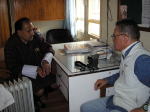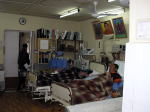Observation report
Hideo Hidai’s Field Trip Report on Dialysis in Bhutan
Dialysis in the Kingdom of Bhutan, the “Shangri-La” of the Himalayas
 April, 2005
I used this year’s Golden Week holiday to visit the Kingdom of Bhutan, a place I had longed to visit for 40 years. For me, Bhutan was a “symbol of my youth”. In those days, the principle of owning one’s own car and home was becoming widespread in Japan, but with youthful impetuosity I rebelled against this trend, choosing instead to put my modern medical knowledge to use in Bhutan, a small Buddhist kingdom closed off to the world in the Himalayan Mountains.
April, 2005
I used this year’s Golden Week holiday to visit the Kingdom of Bhutan, a place I had longed to visit for 40 years. For me, Bhutan was a “symbol of my youth”. In those days, the principle of owning one’s own car and home was becoming widespread in Japan, but with youthful impetuosity I rebelled against this trend, choosing instead to put my modern medical knowledge to use in Bhutan, a small Buddhist kingdom closed off to the world in the Himalayan Mountains.
At the time, Bhutan was sealed off to the outside world and a protectorate of India, so obtaining an entry permit was extremely difficult. But there was just one Japanese person, Mr. Nishioka, who had entered Bhutan to serve as an agricultural adviser under the Colombo Plan. As there was no way to enter Bhutan other than by participating in the Colombo Plan, I visited Mr. Sasuke Nakao, who was Mr. Nishioka’s supervisor, a professor at Osaka Prefecture University, and an authority in the Japanese mountaineering world. I told him what I wanted, and he kindly agreed to write a letter of introduction to Mr. Nishioka for me.
Mr. Nishioka told me that having a Japanese doctor stay in Bhutan would be welcome news, and asked Jigme Dorji Wangchuck, then King, to allow me to enter the country. But I was unable to take advantage of this at the time. Unfortunately, China and India were at war over the McMahon Line, the national border between them, and actually exchanged fire right at the border. India suffered a crushing defeat and its government denied all foreigners’ entry to Bhutan adjacent to China, so Mr. Nishioka’s request to the King was in vain and I was not allowed into the country.
After that, Bhutan became for me a kind of unrequited first love.
My flight from Narita International Airport was in the afternoon of April 29, 2005. Unfortunately, the Bhutan Himalayas were completely hidden by mist and cloud. After circling downward through the fog, the plane lifted its nose up, its wing tip just missing some creeping pines and rocks, and a moment later landed on the ground with a bump. It was 11 am on April 30, and I had arrived at Paro, the smallest international airport in the world.
The local attendant was a young woman who spoke no Japanese but was fluent in English. In general, women in Bhutan seemed very active. She was a typical example, and complied immediately with my wish to find out about dialysis in Bhutan by taking me to a national hospital in Thimphu, the capital of Bhutan. Even though I had no appointment, she called the dialysis doctor from the outpatient department to the dialysis room for an interview with me.
The dialysis room had only 3 beds, and yet there were 16 patients. According to the doctor, three Fresenius 4008 machines were running day and night to treat those patients. The room was clean and organized, and the chief nursing officer had significant knowledge and experience.
 The doctor, an Indian called Dr. Giri, was not a nephrologist. Medical care was free because the hospital was government-run, but its medical equipment was limited. Furthermore, Bhutan has a unique set of circumstances, being a narrow country stretching east to west whose traffic is divided by rivers from the Himalayas running from north to south. Because of this, the bus ride from the eastern end of the country to its capital city, Thimphu takes 3 days. Therefore only a limited number of people in the capital appeared to benefit from dialysis. In this respect, our methods including home hemodialysis seemed very interesting for the doctor in Bhutan, even though medical services there are government-run.
The doctor, an Indian called Dr. Giri, was not a nephrologist. Medical care was free because the hospital was government-run, but its medical equipment was limited. Furthermore, Bhutan has a unique set of circumstances, being a narrow country stretching east to west whose traffic is divided by rivers from the Himalayas running from north to south. Because of this, the bus ride from the eastern end of the country to its capital city, Thimphu takes 3 days. Therefore only a limited number of people in the capital appeared to benefit from dialysis. In this respect, our methods including home hemodialysis seemed very interesting for the doctor in Bhutan, even though medical services there are government-run.
The Kingdom of Bhutan aims to increase its GNH (gross national happiness) rather than its GDP (gross domestic product). For example, even in the export of electricity to India, a precious source of foreign currency for Bhutan’s economy, the country has curtailed large-scale developments that cause pollution, by utilizing small-scale low-head power generation instead of building large-scale dams. The country has also had some unique ideas such as implementation of decentralization, and I was particular interested in the fact that the people sometimes implement them themselves.
Hideo Hidai
Ubiquitous Blood Purification International (UBPI)
